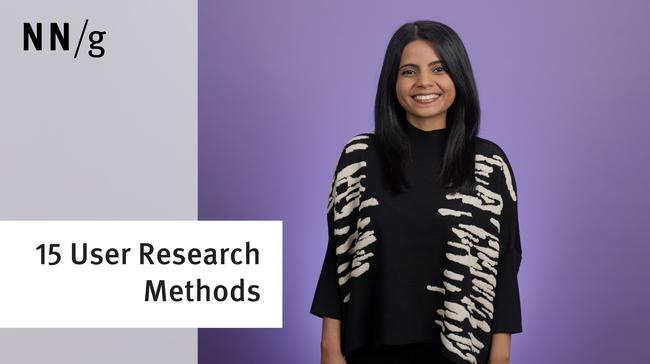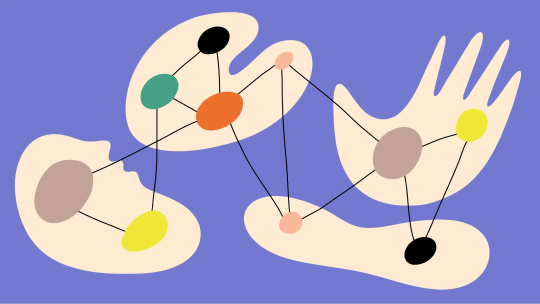

The modern guide to web accessibility
The 4 types of research methods in ui/ux design (and when to use them).
- User Experience
- 4 minute read
- by Rich Staats
Design research is a necessary part of creating a user-centered product. When done right, you’re able to gather data that helps you:
- Identify and solve relevant design problems.
- Better understand the product’s end users.
- Improve your designs based on data-driven research.
Though there are many different ways to collect data and do design research, they can broadly be categorized as either primary, secondary, exploratory, or evaluative research. In this article, we’ll explain these four types of research methods in the context of UI/UX design and when you should use them in your design process.
Primary research

Primary research is the simplest (and perhaps most effective) way to come up with data to get a better understanding of the audience for which you’re designing. The purpose of primary research is to validate design ideas and concepts early on in the design process. The data you collect from primary research allows you to design meaningful, user-centered solutions.
Let’s take a look at some examples of primary research:
Conducting interviews with individuals or in small groups is a great starting point, and there are many ways to go about it. Depending on your project, you might conduct direct interviews or indirect interviews. Direct interviews are simple question-answer format interviews whereas indirect interviews are set up in a more conversational style. You’ll also have to decide whether you’ll interview people in-person or remotely.
Focus groups
Focus groups are structured, group interviews in which a moderator guides the discussion. As a UI/UX designer, you might consider using this research method when you need to gather user insight quickly.
Usability testing
Once you develop a prototype, you can recruit test participants and conduct usability tests to uncover foundational issues with the product’s user experience and gather user feedback. The idea is to define user goals and turn them into realistic task scenarios that the test participants would have to complete using your prototype.
Secondary research

Secondary research is when you use existing books, articles, or research material to validate your design ideas and concepts or support your primary research. For example, you might want to use the material you gather from secondary research to:
- Explain the context behind your UI design.
- Build a case for your design decisions.
- Reinforce the data you gathered from primary research.
Generally speaking, secondary research is much easier (and faster) to do than primary research. You’ll be able to find most of the information you need on the internet, in the library, or your company’s archives. Here are some places you can collect secondary research from:
- Your company’s internal data, which may include information contained in your company’s files, databases and project reports.
- Client’s research department, e.g. the data your client has regarding user behavior with previous versions of the website/application, user interests, etc.
- Industry statistics, i.e. the industry’s general consensus, standards and conventions.
- Relevant books, articles, case studies and magazines.
Websites have evolved a great deal over the last two decades, and so has the way users interact with them. This is why one of the most common challenges with secondary research in UI/UX design is outdated data. In such cases, UI/UX designers resort to other research methods (such as primary research or exploratory research) to gather the data they need.
Exploratory research

Exploratory research is usually conducted at the start of the design process with a purpose to help designers understand the problem they’re trying to solve. As such, it focuses on gathering a thorough understanding of the end user’s needs and goals.
In the Define the Problem stage of the design thinking process , you can use exploratory research techniques to develop a design hypothesis and validate it with the product’s intended user base. By doing so, you’ll be in a better position to make hypothesis-driven design decisions throughout the design process.
You can validate your hypothesis by running experiments. Here are some of the ways you can validate your assumptions depending on where you are in the design process:
- Conducting interviews and surveys
- Organizing focus groups
- Conducting usability tests
- Running various A/B tests
Essentially, you’re combining exploratory research and primary research techniques to define the problem accurately. You can do this by asking questions that encourage interview participants to explore different design concepts and think outside the box.
Before you begin collecting data, remember to write down the experiment you’re running and define the outcomes that validate your design hypothesis. After doing exploratory research, you should have enough data to begin designing a solution.
Evaluative research

Exploratory research gives you enough data to begin designing a solution. Once you have a prototype on hand, you can use evaluative research to test that solution with real users. The goal of evaluative research is to help designers gather feedback that allows them to improve their product’s design.
There are two main functions of evaluative research: summative and formative .
- Summative evaluation is all about making a judgment regarding the efficacy of the product once it’s complete.
- Formative evaluation, on the other hand, focuses on evaluating the product and making improvements (i.e., detecting and eliminating usability problems) during the development process.
For example, you can conduct usability tests in which you ask test participants to use the product to perform a set of tasks. Keep in mind that the purpose of evaluative research is to gather feedback from users regarding your product’s design. In case you’re short on time or low on budget, you can choose to conduct usability studies that fit in your time and budget constraints (such as guerrilla usability testing ).
Deciding which research method to use depends on what data you’re trying to gather and where you are in the design process. The information you collect through your design research will enable you to make informed design decisions and create better user-centered products.
Let’s quickly recap the four types of research methods UI/UX designers can use in the design process:
- Primary research is used to generate data by conducting interviews, surveys, and usability tests and/or organizing focus group sessions.
- With secondary research, you’re able to use existing research material to validate your design ideas and support your primary research.
- Exploratory research is when you come up with a design hypothesis and run experiments to validate it.
- Once you have a prototype, you can use evaluative research to see if there’s any room for improvement.
Which of these research methods do you use in your design process and how? Let us know in the comments section below.
Down The Rabbit Hole

5 Mistakes to avoid when writing task scenarios for usability testing
- 5 minute read
Get the asset
" * " indicates required fields
Request our work
An adventure awaits....
Slangin' the 00110's since 2006
We build kick-ass websites, for kick-ass agencies
We are proudly international
A Complete Guide to Primary and Secondary Research in UX Design

To succeed in UX design, you must know what UX research methods to use for your projects.
This impacts how you:
- Understand and meet user needs
- Execute strategic and business-driven solutions
- Differentiate yourself from other designers
- Be more efficient in your resources
- Innovate within your market
Primary and secondary research methods are crucial to uncovering this. The former is when you gather firsthand data directly from sources, while the latter synthesizes existing data and translates them into insights and recommendations.
Let's dive deep into each type of research method and its role in UX research.
If you are still hungry to learn more, specifically how to apply it practically in the real world, you should check out Michael Wong's UX research course . He teaches you the exact process and tactics he used that helped him build a UX agency that generated over $10M+ million in revenue.
What is p rimary research in UX design
Primary UX research gathers data directly from the users to understand their needs, behaviors, and preferences.
It's done through interviews, surveys, and observing users as they interact with a product.
Primary research in UX: When and why to use it
Primary research typically starts at the start of a UX project. This is so that the design process is grounded in a deep understanding of user needs and behaviors.
By collecting firsthand information early on, teams can tailor their designs to address real user problems.
Here are the reasons why primary research is important in UX design:
1. It fast-tracks your industry understanding
Your knowledge about the industry may be limited at the start of the project. Primary research helps you get up to speed because you interact directly with real customers. As a result, this allows you to work more effectively.
Example: Imagine you're designing an app for coffee lovers. But you're not a coffee drinker yourself. Through user interviews, you learn how they prefer to order their favorite drink, what they love or hate about existing coffee apps, and their "wishlist" features by talking directly to them.
This crucial information will guide you on what to focus on in later stages when you do the actual designing.
2. You'll gain clarity and fill knowledge gaps
There are always areas we know less about than we'd like. Primary research helps fill these gaps by observing user preferences and needs directly.
Example: Let's say you're working on a website for online learning. You might assume that users prefer video lessons over written content, but your survey results show that many users prefer written material because they can learn at their own pace.
With that in mind, you'll prioritize creating user-friendly design layouts for written lessons.
3. You get to test and validate any uncertainties
When unsure about a feature, design direction, or user preference, primary research allows you to test these elements with real users.
This validation process helps you confidently move forward since you have data backing your decisions.
Example: You're designing a fitness app and can't decide between a gamified experience (with points and levels) or a more straightforward tracking system.
By prototyping both options and testing them with a group of users, you discover that the gamified experience concept resonates more.
Users are more motivated when they gain points and progress levels. As a result, you pivot to designing a better-gamified experience.
Types of primary research methods in UX design
Here's a detailed look at common primary research methods in UX:
1. User interviews
- What is it: User interviews involve one-on-one conversations with users to gather detailed insights, opinions, and feedback about their experiences with a product or service.
- Best used for: Gathering qualitative insights on user needs, motivations, and pain points.
- Tools: Zoom and Google Meet for remote interviews; Calendly for scheduling; Otter.ai for transcription.
- What is it: Surveys are structured questionnaires designed to collect quantitative data on user preferences, behaviors, and demographics.
- Best used for: Collecting data from many users to identify patterns and trends.
- Tools: Google Forms, SurveyMonkey, and Typeform for survey creation; Google Sheets and Notion for note taking.
3. Usability testing
- What is it: Usability testing involves observing users interact with a prototype or the actual product to identify usability issues and areas for improvement.
- Best used for: Identifying and addressing usability problems.
- Tools: FigJam, Lookback.io , UserTesting, Hotjar for conducting and recording sessions; InVision, Figma for prototype testing; Google Sheets to log usability issues and track task completion rates.
4. Contextual inquiry
- What is it: This method involves observing and interviewing users in their natural environment to understand how they use a product in real-life situations.
- Best used for: Gaining deep insights into user behavior and the context in which a product is used.
- Tools: GoPro or other wearable cameras for in-field recording; Evernote for note-taking; Miro for organizing insights.
5. Card sorting
- What is it: Card sorting is when users organize and categorize content or information.
- Best used for: Designing or evaluating the information architecture of a website or application.
- Tools: FigJam, Optimal Workshop, UXPin, and Trello for digital card sorting; Mural for collaborative sorting sessions.
6. Focus groups
- What is it: Group discussions with users that explore their perceptions, attitudes, and opinions about a product.
- Best used for: Gathering various user opinions and ideas in an interactive setting.
- Tools: Zoom, Microsoft Teams for remote focus groups; Menti or Slido for real-time polling and feedback.
7. Diary studies
- What is it: A method where users record their experiences, thoughts, and frustrations while interacting with a product over a certain period of time.
- Best used for: Understanding long-term user behavior, habits, and needs.
- Tools: Dscout, ExperienceFellow for mobile diary entries; Google Docs for simple text entries.
8. Prototype testing
- What is it: Prototype testing is when users evaluate the usability and design of early product prototypes with users.
- Best used for: Identifying usability issues and gathering feedback on design concepts
- Tools: Figma for creating and sharing prototypes; Maze for unmoderated testing and analytics.
9. Eye-tracking
- What is it: A method that analyzes where and how long users look at different areas on a screen.
- Best used for: Understanding user attention, readability, and visual hierarchy effectiveness.
- Tools: Tobii, iMotions for hardware; Crazy Egg for website heatmaps as a simpler alternative.
10. A/B testing
- What is it: A/B testing compares two or more versions of a webpage or app feature to determine which performs better in achieving specific goals.
- Best used for: Making data-driven decisions on design elements that impact user behavior.
- Tools: Optimizely, Google Optimize for web-based A/B testing; VWO for more in-depth analysis and segmentation.
11. Field studies
- What is it: Research done in real-world settings to observe and analyze user behavior and interactions in their natural environment.
- Best used for: Gaining insights into how products are used in real-world contexts and identifying unmet user needs.
- Tools: Notability, OneNote for note-taking; Voice Memos for audio recording; Trello for organizing observations.
12. Think-aloud protocols
- What is it: A method involves users verbalizing their thought process while interacting with a product. It helps uncover their decision-making process and pain points.
- Best used for: Understanding user reasoning, expectations, and experiences when using the product.
- Tools: UsabilityHub, Morae for recording think-aloud sessions; Zoom for remote testing with screen sharing.
Challenges of primary research in UX
Here are the obstacles that UX professionals may face with primary research:
- Time-consuming : Primary research requires significant planning, conducting, and analyzing. This is particularly relevant for methods that involve a lot of user interaction.
- Resource intensive : A considerable amount of resources is needed, including specialized tools or skills for data collection and analysis.
- Recruitment difficulties : Finding and recruiting suitable participants willing to put in the effort can be challenging and costly.
- Bias and validity : The risk of bias in collecting and interpreting data highlights the importance of carefully designing the research strategy. This is so that the findings are accurate and reliable.
What is secondary research in UX design
Once primary research is conducted, secondary research analyzes and converts this data into insights. They may also find common themes and ideas and convert them into meaningful recommendations.
Using journey maps, personas, and affinity diagrams can help them better understand the problem.
Secondary research also involves reviewing existing research, published books, articles, studies, and online information. This includes competitor websites and online analytics to support design ideas and concepts.
Secondary research in UX: Knowing when and why to use it
Secondary research is a flexible method in the design process. It fits in both before and after primary research.
At the project's start, looking at existing research and what's already known can help shape your design strategy. This groundwork helps you understand the design project in a broader context.
After completing your primary research, secondary research comes into play again. This time, it's about synthesizing your findings and forming insights or recommendations for your stakeholders.
Here's why it's important in your design projects:
1. It gives you a deeper understanding of your existing research
Secondary research gathers your primary research findings to identify common themes and patterns. This allows for a more informed approach and uncovers opportunities in your design process.
Example: When creating personas or proto-personas for a fitness app, you might find common desires for personalized workout plans and motivational features.
This data shapes personas like "Fitness-focused Fiona," a detailed profile that embodies a segment of your audience with her own set of demographics, fitness objectives, challenges, and likes.
2. Learn more about competitors
Secondary research in UX is also about leveraging existing data in the user landscape and competitors.
This may include conducting a competitor or SWOT analysis so that your design decisions are not just based on isolated findings but are guided by a comprehensive overview. This highlights opportunities for differentiation and innovation.
Example: Suppose you're designing a budgeting app for a startup. You can check Crunchbase, an online database of startup information, to learn about your competitors' strengths and weaknesses.
If your competitor analysis reveals that all major budgeting apps lack personalized advice features, this shows an opportunity for yours to stand out by offering customized budgeting tips and financial guidance.
Types of secondary research methods in UX
1. competitive analysis.
- What is it: Competitive analysis involves systematically comparing your product with its competitors in the market. It's a strategic tool that helps identify where your product stands about the competition and what unique value proposition it can offer.
- Best used for: Identifying gaps in the market that your product can fill, understanding user expectations by analyzing what works well in existing products, and pinpointing areas for improvement in your own product.
- Tools: Google Sheets to organize and visualize your findings; Crunchbase and SimilarWeb to look into competitor performance and market positioning; and UserVoice to get insights into what users say about your competitors.
2. Affinity mapping
- What is it: A collaborative sorting technique used to organize large sets of information into groups based on their natural relationships.
- Best used for: Grouping insights from user research, brainstorming sessions, or feedback to identify patterns, themes, and priorities. It helps make sense of qualitative data, such as user interview transcripts, survey responses, or usability test observations.
- Tools: Miro and FigJam for remote affinity mapping sessions.

3. Customer journey mapping
- What is it: The process of creating a visual representation of the customer's experience with a product or service over time and across different touchpoints.
- Best used for: Visualizing the user's path from initial engagement through various interactions to the final goal.
- Tools: FigJam and Google Sheets for collaborative journey mapping efforts.
4. Literature and academic review
- What is it: This involves examining existing scholarly articles, books, and other academic publications relevant to your design project. The goal is to deeply understand your project's theoretical foundations, past research findings, and emerging trends.
- Best used for: Establishing a solid theoretical framework for your design decisions. A literature review can uncover insights into user behavior and design principles that inform your design strategy.
- Tools: Academic databases like Google Scholar, JSTOR, and specific UX/UI research databases. Reference management tools like Zotero and Mendeley can help organize your sources and streamline the review process.
Challenges of secondary research in UX design
These are the challenges that UX professionals might encounter when carrying out secondary research:
- Outdated information : In a world where technology changes fast, the information you use must be current, or it might not be helpful.
- Challenges with pre-existing data : Using data you didn't collect yourself can be tricky because you have less control over its quality. Always review how it was gathered to avoid mistakes.
- Data isn't just yours : Since secondary data is available to everyone, you won't be the only one using it. This means your competitors can access similar findings or insights.
- Trustworthiness : Look into where your information comes from so that it's reliable. Watch out for any bias in the data as well.
The mixed-method approach: How primary and secondary research work together
Primary research lays the groundwork, while secondary research weaves a cohesive story and connects the findings to create a concrete design strategy.
Here's how this mixed-method approach works in a sample UX project for a health tech app:
Phase 1: Groundwork and contextualization
- User interviews and surveys (Primary research) : The team started their project by interviewing patients and healthcare providers. The objective was to uncover the main issues with current health apps and what features could enhance patient care.
- Industry and academic literature review (Secondary research) : The team also reviewed existing literature on digital health interventions, industry reports on health app trends, and case studies on successful health apps.
Phase 2: Analysis and strategy formulation
- Affinity mapping (Secondary research) : Insights from the interviews and surveys were organized using affinity mapping. It revealed key pain points like needing more personalized and interactive care plans.
- Competitive benchmarking (Secondary research) : The team also analyzed competitors’ apps through secondary research to identify common functionalities and gaps. They noticed a lack of personalized patient engagement and, therefore, positioned their app to fill this void in the market.
Phase 3: Design and validation
- Prototyping (Secondary research) : With a good grasp of what users need and the opportunities in the market, the startup created prototypes. These prototypes include AI-powered personalized care plans, reminders for medications, and interactive tools to track health.
- Usability testing (Primary research) : The prototypes were tested with a sample of the target user group, including patients and healthcare providers. Feedback was mostly positive, especially for the personalized care plans. This shows that the app has the potential to help patients get more involved in their health.
Phase 4: Refinement and market alignment
- Improving design through iterations: The team continuously refined the app's design based on feedback from ongoing usability testing.
- Ongoing market review (Secondary research) : The team watched for new studies, healthcare reports, and competitors' actions. This helped them make sure their app stayed ahead in digital health innovation.
Amplify your design impact and impress your stakeholders in 10+ hours
Primary and secondary research methods are part of a much larger puzzle in UX research.
However, understanding the theoretical part is not enough to make it as a UX designer nowadays.
The reason?
UX design is highly practical and constantly evolving. To succeed in the field, UX designers must do more than just design.
They understand the bigger picture and know how to deliver business-driven design solutions rather than designs that look pretty.
Sometimes, the best knowledge comes from those who have been there themselves. That's why finding the right mentor with experience and who can give practical advice is crucial.
In just 10+ hours, the Practical UX Research & Strategy Course dives deep into strategic problem-solving. By the end, you'll know exactly how to make data-backed solutions your stakeholders will get on board with.
Master the end-to-end UX research workflow, from formulating the right user questions to executing your research strategy and effectively presenting your findings to stakeholders.
Learn straight from Mizko—a seasoned industry leader with a track record as a successful designer, $10M+ former agency owner, and advisor for tech startups.
This course equips you with the skills to:
- Derive actionable insights through objective-driven questions.
- Conduct unbiased, structured interviews.
- Select ideal participants for quality data.
- Create affinity maps from research insights.
- Execute competitor analysis with expertise.
- Analyze large data sets and user insights systematically.
- Transform research and data into actionable frameworks and customer journey maps.
- Communicate findings effectively and prioritize tasks for your team.
- Present metrics and objectives that resonate with stakeholders.
Designed for flexible and independent learning, this course allows you to progress independently.
With 4000+ designers from top tech companies like Google, Meta, and Squarespace among its alumni, this course empowers UX designers to integrate research skills into their design practices.
Here's what students have to say about the 4.9/5 rated course:
"I'm 100% more confident when talking to stakeholders about User Research & Strategy and the importance of why it needs to be included in the process. I also have gained such a beautiful new understanding of my users that greatly influences my designs. All of the "guesswork" that I was doing is now real, meaningful work that has stats and research behind it." - Booking.com Product Designer Alyssa Durante
"I had no proper clarity of how to conduct a research in a systematically form which actually aligns to the project. Now I have a Step by Step approach from ground 0 to final synthesis." - UX/UI Designer Kaustav Das Biswas
"The most impactful element has been the direct application of the learnings in my recent projects at Amazon. Integrating the insights gained from the course into two significant projects yielded outstanding results, significantly influencing both my career and personal growth. This hands-on experience not only enhanced my proficiency in implementing UX strategies but also bolstered my confidence in guiding, coaching, mentoring, and leading design teams." - Amazon.com UX designer Zohdi Rizvi
Gain expert UX research skills and outshine your competitors.
Mizko, also known as Michael Wong, brings a 14-year track record as a Founder, Educator, Investor, and Designer. His career evolved from lead designer to freelancer, and ultimately to the owner of a successful agency, generating over $10M in revenue from Product (UX/UI) Design, Web Design, and No-code Development. His leadership at the agency contributed to the strategy and design for over 50 high-growth startups, aiding them in raising a combined total of over $400M+ in venture capital.
Notable projects include: Autotrader (Acquired. by eBay), PhoneWagon (Acquired by CallRails), Spaceship ($1B in managed funds), Archistar ($15M+ raised) and many more.
Table of contents
The design pulse.

New website, course and product updates - April 2024

Using Quantitative and Qualitative Research in UX Design

10 Best Free Fonts for UI Design (2024 Edition)

The Ultimate Guide to UX/UI Design in 2024

16 Best UX Research Tools in 2024: Gather Faster & Better Insights

15 Most Effective UX Research Methods: Pros and Cons

The Ultimate Guide to Figma for Beginners (Updated 2024)

The Ultimate Guide to UX Research (Updated 2024)

5 Reasons Why You Need UX Research in 2024
Join our newsletter.

Get 10% off on your first purchase
Secondary Research in UX

February 20, 2022 2022-02-20
- Email article
- Share on LinkedIn
- Share on Twitter
You don’t have to do all the user-research work yourself. If somebody else already ran a study (and published it), grab it!
Have you ever completed a project only to find out that something very similar has already been done in your organization a couple of years ago? That situation is common, especially with rising employee-churn rates, and fueled the popularity of research repositories (e.g., Microsoft Human Insights System) and the growth of the research-operations community . It should also inspire practitioners to do more secondary research.
Secondary research, also known as desk research or, in academic contexts, literature review, refers to the act of gathering prior research findings and other relevant information related to a new project. It is a foundational part of any emerging research project and provides the project with background and context. Secondary research allows us to stand on the shoulders of giants and not to reinvent the wheel every time we initiate a new program or plan a study.
This article provides a step-by-step guide on how to conduct secondary research in UX. The key takeaway is that this type of research is not solely an intellectual exercise, but a way to minimize research costs, win internal stakeholders and get scaffolding for your own projects.
Academic publications include a literature review at the beginning to showcase context or known gaps and to justify the motivation for the research questions. However, the task of incorporating previous results is becoming more and more challenging with a growing number of publications in all fields. Therefore, practitioners across disciplines (for instance in eHealth, business, education, and technology) develop method guidelines for secondary research.
In This Article:
When to conduct secondary research, types of secondary research, how to conduct secondary research.
Secondary research should be a standard first step in any rigorous research practice, but it’s also often cost-effective in more casual settings. Whether you are just starting a new project, joining an existing one, or planning a primary research effort for your team, it is always good to start with a broad overview of the field and existent resources. That would allow you to synthesize findings and uncover areas where more research is needed.
Secondary research shows which topics are particularly popular or important for your organization and what problems other researchers are trying to solve. This research method is widely discussed in library and information sciences but is often neglected in UX. Nonetheless, secondary research can be useful to uncover industry trends and to inspire further studies. For example, Jessica Pater and her colleagues looked at the foundational question of participant compensation in user studies. They could have opted for user interviews or a costly large-scale survey, yet through secondary research, they were able to review 2250 unique user studies across 1662 manuscripts published in 2018-2019. They found inconsistencies in participant compensation and suggested changes to the current practices and further research opportunities.
Secondary research can be divided into two main types: internal and external research.
Internal secondary research involves gathering all relevant research findings already available in your organization. These might include artifacts from the past primary research projects, maps (e.g., customer-journey map , service blueprint ), deliverables from external consultants, or results from different kinds of workshops (e.g., discovery, design thinking, etc.). Hopefully, these will be available in a research repository .
External secondary research is focused on sources outside of your organization, such as academic journals, public libraries, open data repositories, internet searches, and white papers published by reputable organizations. For example, external resources for the field of human-computer interaction (HCI) can be found at the Association for Computing Machinery (ACM) digital library , Journal of Usability Studies (JUS ), or research websites like ours . University libraries and labs like UCSD Geisel Library , Carnegie Mellon University Libraries , MIT D-Lab , Stanford d.school , and specialized portals like Google Scholar offer another avenue for directed search.
Our goal is to have the necessary depth, rigor, and usefulness for practitioners. Here are the 4 steps for conducting secondary research:
- Choose the topic of research & write a problem statement .
Write a concise description of the problem to be solved. For example, if you are doing a website redesign, you might want to both learn the current standards and look at all the previous design iterations to avoid issues that your team already identified.
- Identi fy external and internal resources.
Peer-reviewed publications (such as those published in academic journals and conferences) are a fairly reliable source. They always include a section describing methods, data-collection techniques, and study limitations. If a study you plan to use does not include such information, that might be a red flag and a reason to further scrutinize that source. Public datasets also often present some challenges because of errors and inclusion criteria, especially if they were collected for another purpose.
One should be cautious of the seemingly reputable “research” findings published across different websites in a form of blog posts, which could be opinion pieces, not backed up by primary research. If you encounter such a piece, ask yourself — is the conclusion of the writeup based on a real study? If the study was quantitative, was it properly analyzed (e.g., at the very least, are confidence intervals reported, and was statistical significance evaluated?). For all studies, was the method sound and nonbiased (e.g., did the study have internal and external validity )?
A more nuanced challenge involves evaluating findings based on a different audience, which might not be always generalizable to your situation, but may form hypotheses worthy of investigating. For example, if a design pattern is found okay to use by young adults, you may still want to know if this finding will also be valid for older generations.
- Collect and analyze data from external and internal resources.
Remember that secondary research involves both the existing data and existing research. Both of those categories become helpful resources when they are critically evaluated for any inherent biases, omissions, and limitations. If you already have some secondary data in your organization, such as customer service logs or search logs, you should include them in secondary research alongside any existent analysis of such logs and previous reports. It is helpful to revisit previous findings, compare how they have or have not been implemented to refresh institutional memory and support future research initiatives.
- Refine your problem statement and determine what still needs to be investigated.
Once you collected the relevant information, write a summary of findings, and discuss them with your team. You might need to refine your problem statement to determine what information you still need to answer your research questions. Next time your team is planning to adopt a trendy new design pattern, it may be a good idea to go back and search the web or an academic database for any evaluations of that pattern.
It is important to note that secondary research is not a substitute for primary research. It is always better to do both. Although secondary research is often cost-effective and quick, its quality depends to a large extent on the quality of your sources. Therefore, before using any secondary sources, you need to identify their validity and limitations.
Secondary (or desk) research involves gathering existing data from inside and outside of your organization. A literature review should be done more frequently in UX because it is a viable option even for researchers with limited time and budget. The most challenging part is to persuade yourself and your team that the existing data is worth being summarized, compared, and collated to increase the overall effectiveness of your primary research.
Jessica Pater, Amanda Coupe, Rachel Pfafman, Chanda Phelan, Tammy Toscos, and Maia Jacobs. 2021. Standardizing Reporting of Participant Compensation in HCI: A Systematic Literature Review and Recommendations for the Field. In Proceedings of the 2021 CHI Conference on Human Factors in Computing Systems. Association for Computing Machinery, New York, NY, USA, Article 141, 1–16. https://doi.org/10.1145/3411764.3445734
Hannah Snyder. 2019. Literature review as a research methodology: An overview and guidelines. Journal of business research 104, 333-339. DOI: https://doi.org/10.1016/j.jbusres.2019.07.039.
Related Courses
Discovery: building the right thing.
Conduct successful discovery phases to ensure you build the best solution
User Research Methods: From Strategy to Requirements to Design
Pick the best UX research method for each stage in the design process
ResearchOps: Scaling User Research
Orchestrate and optimize research to amplify its impact
Related Topics
- Research Methods Research Methods
Learn More:

Competitive Reviews vs. Competitive Research
Therese Fessenden · 4 min

15 User Research Methods to Know Beyond Usability Testing
Samhita Tankala · 3 min

Always Pilot Test User Research Studies
Kim Flaherty · 3 min
Related Articles:
Open-Ended vs. Closed Questions in User Research
Maria Rosala · 5 min
UX Research Methods: Glossary
Raluca Budiu · 12 min
Recruiting and Screening Candidates for User Research Projects
Therese Fessenden · 10 min
ResearchOps: Study Guide
Kate Kaplan and Maria Rosala · 5 min
International Usability Testing: Why You Need It
Feifei Liu · 10 min
Triangulation: Get Better Research Results by Using Multiple UX Methods
Kathryn Whitenton · 3 min
Skip to main content
- Contact sales
- Get started Get started for free
Figma Design
Design and prototype in one place

Collaborate with a digital whiteboard

Translate designs into code

Figma Slides
Co-create presentations

Explore all Figma AI features
Get the desktop, mobile, and font installer apps
See the latest features and releases
- Design systems
- Prototyping
- Wireframing
- Online whiteboard
- Team meetings
- Strategic planning
- Brainstorming
- Diagramming
- Product development
- Web development
- Design handoff
- Engineering
- Product managers
Organizations
Creator fund
Build and sell what you love
User groups
Join a local Friends of Figma group
Learn best practices at virtual events
Customer stories
Read about leading product teams
Shortcut: The Figma blog
Stories about how products take shape—and shape our world

Get started
- Developer docs
- Best practices
- Reports & insights
- Resource library
- Help center
UX design research methods

Effective user experience design is intuitive, accessible, and engaging. But how do you design a delightful experience that meets your target audience’s needs? Conducting user experience research gives you a glimpse inside your users’ heads, so you can understand what they care about and the challenges they face.
In this article, Figma Designer Advocate Ana Boyer weighs in on:
- What user experience research is, and why your team needs it
- Different types of UX research that support product development
- UX design research methods made easier with Figma
What is user experience research?
User experience research helps design teams identify areas of opportunity to improve user interfaces and enhance the overall user experience. According to Ana, UX research can reveal insights about target users across all phases of product development—from strategy and planning to product launch and post-launch improvements. A robust UX research framework includes both quantitative and qualitative research.
Quantitative research
Using information gathered from larger sample sizes, quantitative research yields concrete numerical data that reveals what users are doing. Researchers run statistical analyses and review analytics to gain insights into user behavior. For example, Ana says, “you might try tracking the number of times users clicked a CTA button on a newly designed web page, compared to an old version."
Qualitative research
For qualitative research, researchers collect subjective and descriptive feedback directly from users, tapping into users’ personal feelings and experiences with a product or design. "Qualitative research gives you a more thorough explanation of why someone is doing something in the context of a flow,” Ana says.
User-centered design research often covers two types of qualitative research: attitudinal and behavioral. Attitudinal research examines users’ self-reported beliefs and perceptions related to a user experience, while behavioral research focuses on observing first-hand what users do with a product.
Sign up for Figma today
With Figma, you can create low or high fidelity designs for free. Sign up today.
3 benefits of user experience research
According to Ana, with UX research you can:
- Validate your design. "You can learn whether or not your design is hitting project goals and your users are able to accomplish a task—for example, ordering an item from your platform.”
- Put your users front and center. UX research uncovers what users want and need, so you can deliver a product that delights customers.
- Save time and resources. Doing user research and testing early and often allows you to make smaller adjustments quickly and easily. That way, Ana says, “you can take a more iterative approach to design—without having to backtrack and redo your entire UX design.”
How to conduct UX research
Most common UX research methodologies break down into these essential activities:
- Observe how users act and react . This not only includes clicks and scrolling onscreen, but also their body language and facial expressions. Careful observation helps you understand how users normally perform a task, what interactions users pick up easily or enjoy, where they get stuck in a flow, and more.
- Empathize with your users . To create a useful and usable product, you need to consider how users' context influences them as they interact with your design.
- Analyze information to surface common themes. “Tagging key user responses helps you pinpoint what needs the most work and refinement to improve the user experience," Ana advises
When to use key UX research methods—at a glance
Given all the UX research methods you can use for product development, when is each most useful? Ana offers these pro tips.
- User personas help you understand your core users in the early stages of development. “If you don’t know who you’re building for, then the time you invest in building and creating something will be wasted,” Ana explains. FigJam’s user persona template will help you get the ball rolling.
- Interviews gather in-depth information directly from users to test your ideas, so you can lower the risk of building a product that misses the target. FigJam’s user interview template will help you lay the groundwork.
- Card sorting invites users to show you what they think is the most intuitive way to organize high-level information in your design. Try FigJam’s card-sorting tool to shape your product’s information architecture.
- Task analysis studies users as they use your site or app to complete tasks, or jobs to be done. Use it to validate your design, and ensure users can quickly and easily accomplish their goals. Get started with FigJam’s jobs to be done template .
- Eye tracking analyzes where users look, when, and how long as they interact with your product.
- Surveys indicate how useful and usable your design is. Surveys can provide useful insights at any phase of product development, pinpointing where users are struggling with an interface, and revealing user sentiment about a product’s colors, fonts, and overall design.
Launch & post-launch
- A/B testing shows which version or iteration of a webpage, app screen, or CTA button performs better with your users.
- Analytics track KPIs like time spent on page, bounce rate, number of clicks on key CTAs, and more to see what’s working—and what isn’t. Analytics may also reveal useful insights about your users, including location, device usage, age, and gender.
- Usability bug testing identifies and helps fix usability issues that affect your product’s quality and ease of use. “Teams struggle to invest the time and process in doing this, but it can have a huge impact on quality,” Ana says.
- Diaries captured in writing or on video track users’ thoughts and impressions over a certain time period. This self-reporting approach reveals how a product fits into and enhances users’ daily lives.
Kick off user experience research with Figma
No matter where you are in the product development process, FigJam’s research plan template can help you define your research goals. Figma’s research and design templates help you conduct research with user interviews , user personas , card sorting , and Sprig study integration .
With the insights gained from your research, you're ready to design, develop, and prototype engaging user experiences. Use Figma’s UX design tool to:
- Give and receive instant feedback on designs or prototypes—and enjoy real-time collaboration with your team. Figma's Maze integration makes testing prototypes easy.
- Set up design libraries to quickly launch user research projects and improve UX design.
- Easily share assets between Figma and FigJam to help keep your projects moving forward.
To jumpstart your UX research, browse inspiring UX research resources shared by the Figma community .
Now you're ready to roll with UX research!
Go to next section
[1] https://www.nngroup.com/articles/which-ux-research-methods/
[2] https://www.uxbooth.com/articles/complete-beginners-guide-to-design-research/

IMAGES
VIDEO
COMMENTS
Unlock the secrets of UX success with our in-depth guide on primary and secondary research methods. Discover tools, strategies, and examples to elevate your user experience design projects. Perfect for beginners and seasoned professionals alike.
This article provides a step-by-step guide on how to conduct secondary research in UX. The key takeaway is that this type of research is not solely an intellectual exercise, but a way to minimize research costs, win …
A UX research method is a way of generating insights about your users, their behavior, motivations, and needs. These methods help: Learn about user behavior and attitudes. Identify …
In this article, Figma Designer Advocate Ana Boyer weighs in on: What user experience research is, and why your team needs it. Different types of UX research that support product development. UX design research methods …
Primary research is essentially coming up with new data to understand who you are designing for and what you would potentially plan on designing. It allows us to validate our ideas with our users and design more …
Secondary research is when you use existing data like books, articles, or the internet to validate or support existing research. You may use secondary research to create a stronger case for your design choices and …